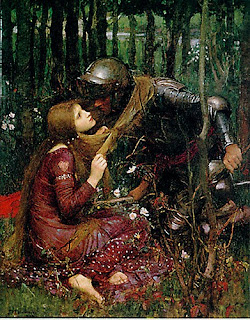 |
| La belle dame sans merci, by J. W. Waterhouse This was used as the original cover art for this set's 1998 release. © 1898 The Estate of J.W. Waterhouse |
The 1998 recording of Lohengrin has a strong, if idiosyncratic cast. Emily Magee is an idiosyncratic, dreamy Elsa who does not match up to some of the more famous sopranos who have tackled this difficult role. However, she emerges from a dream-like state to evolve into a fully realized heroine.
Ms. Magee is well-matched with Deborah Polaski, who is a favorite on Mr. Barenboim's recordings. Here, she is Ortrud, the villainess of the piece, and their clash in Act II makes for exciting aural theater.
Peter Seiffert is heroic in the title role, singing with noble tone. Unusually, Barenboim chooses to open the standard cut in the second stanza of "In Fernem Land." This verse gives Lohengrin's perspective on the events of the last three acts, and increases the tragic weight of the opera's final scene. And Wagnerphiles take note: this is only the second recording of Lohengrin to include the whole aria. (The cut was suggested by Wagner before the opera's premiere. He had doubts about an under-powered tenor in the title role.)
Falk Struckmann, another "regular player" in Mr. Barenboim's cast, is good, if not ideal as Telramund, the baritone villain who is caught in the machinations of his wife Ortrud's plot. He has a powerful, dark voice, and is especially strong in the big Act II duet with Ms. Polaski, as the two of them bicker beneath the castle walls and then mutually declare their villainous nature.
Mr. Barenboim is an expert Wagner conductor with pin-point control over his Staatskapelle Belin forces. He frequently uses rubato to speed and slow the pacing as needed. This pays off in Act III following the death of Telramund as the orchestra detonates with shattering force. The playing is top-drawer, as is the choral work. The choristers are crystal-clear, providing the flexible many-voiced instrument that is crucial for this opera's many public scenes.


